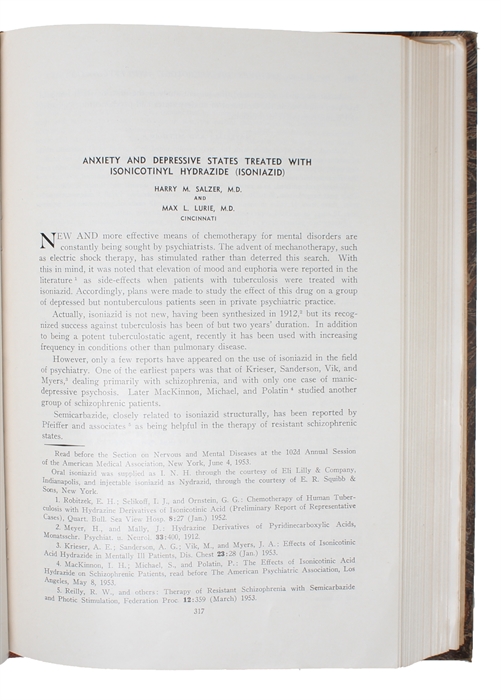THE DISCOVERY OF ANTIDEPRESSANTS
SALZER, HARRY M. and MAX L. LURIE.
Anxiety and Depressive States Treated With Asonicotinyl Hydrazide (Isoniazid). [In: A.M.A. Archives of Neurology and Psychiatry. Vol. 70, 1953].
Chicago, 1953.
Lex 8vo. Entire volume present. Contemporary brown half cloth with type-written paper title-label to spine. A nice and clean copy. Pp. 317-324. [Entire volume: VI, 10, (2), 819, (1) pp].
Seminal first printing of the groundbreaking paper that founded the field of antidepressant medicine, being the paper that reported for the first time the first discovery in the antidepressant field, namely the first specific antidepressant drug. It is with the report of the present paper that isoniazide becomes the first antidepressant in clinical history, thus founding a field that the modern world could hardly be imagined without, sparking a kind of treatment that is now presumably the most frequently prescribed in the Western world.
"As far as can be ascertained, the present study is the first in which isoniazid has been employed in the treatment of anxiety states and psychoneurotic, agitated, and manic-depressive depressions." (Present paper, p. 318).
In 1951 a series of hydrazide derivatives was introduced for the treatment of tuberculosis, the best known of them being isoniazid and iproniazid. Isoniazid was not a newly discovered drug, having been synthesized in 1912, but its recognized success against tuberculosis was. The impact of the drug was truly remarkable and stories of the effect on patients came from various places, most dramatically from New York's Sea View Hospital. These reports captured the attention of the media; e.g. "Life" magazine ran an article showing patients dancing in the wards.
"These articles caught the attention of many psychiatrists. Phyychiatrists throughout the United States were tempted to prescribe these compounds for mental health purposes, given the effects of these drugs to boost appetite, cause weight gain, increase vitality, and improve sleep. The conventional wisdom is that no indications emerged from any of these efforts.
Stimulated by the reports of improved sleep and appetite by Robitzek et al. (1952) and probably the feature in "Life", Max Lurie and Harry Salzer made the first discovery in the antidepressant field in 1952. following the suggestions that isoniazid appeared to treat tuberculosis and enhance the sense of well-being of the patients receiving the drug, Lurie, like Jackson Smith thought isoniazid might be a useful agent to help depressed patients... Lurie was probably the person who coined the term "antidepressant" in 1952." (Weissman: Treatment of Depression. Bridging the 21st Century, pp. 10-11).
"On June 4, 1953, a paper was read before the section on nervous and mental diseases at the 102nd annual session of the American Medical Association in New York detailing the effects of isoniazid in forty-one patients suffering from anxiety and depression. Two-thirds of those to whom it was given improved, and among those improving were a number who had previously only responded to ECT. Improvement took up to three weeks to appear. The authors were Harry Slzer, an assistant professor of neurology at the Cincinatti College of Medicine, and Max Lurie, an instrutor in psychiatry at the same university. Both were attending psychiatrists at the Cincinatti General Hospital." (Healy: The Antidepressant Era, p. 72).
Salzer and Lurie thus became the first to recognize, test, and describe the effects of an actual, clinical, antidepressant drug (i.e. in the present paper). "This report deals with the early results noted in a group of 41 patients, most of whom were suffering from depressive states of the psychoneurotic, agitated, or manic-depressive types, and one of whom had a pure anxiety state. They were given isoniazid, and the effect on their mental status, as well as on their various symptoms, was studied." (Present paper, p. 318).
The discovery of antidepressants must count as one of the most important discoveries for modern man. According to a government study, antidepressants have now become the most commonly prescribed drugs in the United States. They're prescribed more than drugs to treat high blood pressure, high cholesterol, asthma, or headaches.
In its study, the U.S. Centers for Disease Control and Prevention looked at 2.4 billion drugs prescribed in visits to doctors and hospitals in 2005. Of those, 118 million were for antidepressants. The same tendency occurs througout the rest of the Western World.
Order-nr.: 49147


![Anxiety and Depressive States Treated With Asonicotinyl Hydrazide (Isoniazid). [In: A.M.A. Archives of Neurology and Psychiatry. Vol. 70, 1953].](/images/product/49147b.jpg)
![Anxiety and Depressive States Treated With Asonicotinyl Hydrazide (Isoniazid). [In: A.M.A. Archives of Neurology and Psychiatry. Vol. 70, 1953].](/images/product/49147c.jpg)